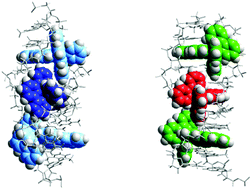Binding of Ru(terpyridine)(pyridine)dipyridophenazine to DNA studied with polarized spectroscopy and calorimetry†
Abstract
Linear and circular dichroism (LD and CD) spectroscopy as well as isothermal titration calorimetry (ITC) have been used to investigate the interaction of Ru(tpy)(py)dppz2+ (tpy = 2,2′:6′,2′′-terpyridyl; py = pyridine; dppz = dipyrido[3,2-a:2′3′-c]phenazine) with DNA, providing detailed information about the DNA binding thermodynamics and binding geometry of the metal complex. Flow LD, CD and isotropic absorption indicate that Ru(tpy)(py)dppz2+ bind to DNA from the minor groove with the dppz ligand intercalated between base pairs, very similar to its chiral structural isomers Δ- and Λ-Ru(bpy)2dppz2+ (bpy = 2,2′-bipyridine). A simple cooperative binding model with one binding geometry provide an excellent fit for calorimetric and absorption titration data. The values of the neighbor interaction thermodynamic parameters for Ru(tpy)(py)dppz2+ suggest that complexes bound contiguously prefer to have their tpy ligands oriented towards the same strand.

- This article is part of the themed collection: Metal Interactions with Nucleic Acids

 Please wait while we load your content...
Please wait while we load your content...